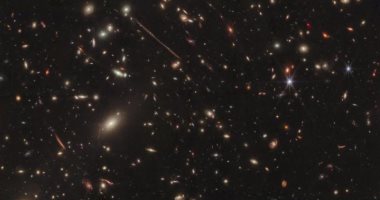Written by Samah Labib Sunday, August 06, 2023 04:00 AM
A recent image from the James Webb Space Telescope revealed the most massive cluster of galaxies we know of – one so big it’s been nicknamed El Gordo, or the fat cluster, thought to be more than 2 quadrillion times the mass of the Sun, located 7 billion light-years away and hosting hundreds of gravitationally bound galaxies Together, as reported by digitartlends.
The image was taken using Webb’s NIRCam instrument, which was able to take the most detailed look yet at this massive cluster and the many galaxies within it.
Because the cluster has so much mass, its images show a phenomenon called gravitational lensing, in which massive objects in the foreground bend space-time and amplify the light coming from distant background galaxies. A galaxy called the Thin One (near center image to lower left) and the Fish Hook (red hook shape to upper right).
Brenda Fry of the University of Arizona, the researcher who worked on analyzing these observations, explained in a statement: Lensing by El Gordo enhances the brightness and magnifies the sizes of distant galaxies.. This lensing effect provides a unique window into the distant universe.
A very small group of galaxies has also been observed in the early stages of formation, which are very far away as they were more than 12 billion years ago.
“Although additional data is needed to confirm the presence of 17 members in this group, we may be witnessing a new group of galaxies forming right before our eyes, more than a billion years after the Big Bang,” Frey said.
The researchers recorded this data as part of a project called PEARLS (Primary Extragalactic Regions for Reionization and Lens Science) which is using Webb’s observations to search for these lensed objects. Gravitational lensing was predicted by Albert Einstein over 100 years ago.
“In the El Gordo pool, we see the power of gravitational lensing at work,” said Roger Windhorst of Arizona State University, principal investigator for the PEARLS program. “The PEARLS images of El Gordo are pretty out of this world and they showed us how Webb could open Einstein’s treasure chest.”


